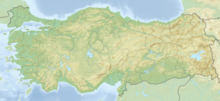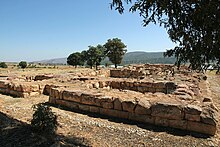Šapinuwa
Coordinates: 40 ° 15 ′ 10 ″ N , 35 ° 14 ′ 15 ″ E
Šapinuwa or Schapinuwa (also called Sapanuwa ) was a Hittite royal seat in northern Anatolia. It is located about two kilometers southwest of Ortaköy in the district of the same name in the Turkish province of Çorum .
location
The city lies on the route that leads from the Hittite capital Ḫattuša in the west through the Sungurlu / Alacahöyük plain to the east through the Kelkit Çayı river valley into the Caucasus . It thus assumed a strategically important position. It extends in a side valley of the river Çekerek Çayı over flat terraces over an area of nine square kilometers.
description
Šapinuwa has been excavated since 1990 by a team from Ankara University led by Aygül and Mustafa Süel. The first structure excavated is called Building A. It is rectangular and has a floor area of 2500 m². The foundation walls consist of Cyclopean blocks of limestone and sandstone at a height and thickness of about two meters, above which mud brick walls were connected . From the amounts of rubble found, it can be concluded that the monumental building had at least two upper floors. Cedar wood from Mount Karadağ near Ortaköy, which can be identified as the Hittite Mount Šakaddunuwa , was used in the ceilings . The floor plan is oriented from the southeast to the northwest, in the north there are further buildings, possibly utility rooms. A double-walled protective wall surrounds the building. The building was completely destroyed by fire, after which the entire place was abandoned. More than 4,000 fragments of cuneiform tablets were found in the fire rubble on the upper floors, but only a fraction of these have been published so far.
Another excavation in 1994 unearthed Building B, which is approximately 25 × 40 meters in size, 160 meters southeast of it. On the foundation walls of carefully worked stone blocks, 1.10 meters thick mud brick walls with a 2-3 centimeter thick layer of plaster were found. About 40 pithoi emerged inside the building . They served as storage vessels for various kinds of food. Building B had at least one upper floor.
Finds
About two thirds of the cuneiform tablets found in Building A are in Hittite , a smaller part in Hurrian , the rest is Akkadian or bilingual Hittite-Hurrian, Hittite-Akkadian or Hittite- Hattic . Most of them are letters, but also texts of a religious nature, omen and lists. Since a considerable part of the letters, in addition to high officials, have the great king or queen as addressee or sender, it can be assumed that Šapinuwa was a residential city. The Hurrian texts are predominantly religious in content and refer mainly to the itkalzi ritual, a cleansing ritual. Due to the numerous names appearing in the texts, which are also documented in texts from Maşat Höyük , the excavators date the city to the 14th century BC. In the time of the Hittite empire.
Numerous small finds were also unearthed, including ceramics, seals, arrowheads, axes and other small metal finds. They are exhibited in the Archaeological Museum of Çorum . In building D, south of B, the relief of a warrior came to light.
According to a cuneiform text from Boğazköy about the delivery of clay vessels, perhaps for cult purposes (KUB 25.28 i 1-10), the city was about 100 km from Ḫattuša , assuming an average daily output of a transport cart of 30-35 km. The Hurrian weather god worshiped here ( Hurrian Teššub Šapinuwa = ḫi) is mentioned in the Šuppiluliuma- Šattiwaza Treaty (KBo 1.3).
literature
- Aygül Süel: Ortaköy-Šapinuwa. In: Recent Developments in Hittite Archeology and History, Papers in Memory of Hans G. Güterbock. Eisenbrauns, Winona Lake, Indiana 2002 pp. 157-165 ISBN 1-57506-053-1
- Mustafa Süel: Bir Hitit Başkenti. Ortaköy - Şapinuva. Uyum Ajans Ankara 2008
- Maciej Popko : Zippalanda and Ankuwa once more. Journal American Oriental Society 120/3, 2000, 445-448.
- Maciej Popko: Zippalanda: A Cult Center in Hittite Asia Minor (1994).
- Marie-Henriette Gates: Archeology in Turkey. American Journal of Archeology 100/2, 1996, 277-335.
- Aygül Süel: The Religious Significance and Sacredness of the Hittite Capital City Sapinuwa In: Anacleto D'Agostimo, Valentina Orsi, Giulia Torri (eds.): Sacred Landscapes of Hittites and Luwians , Firenze University Press 2015 ISBN 978-88-6655-903 -0 pp. 101-111.
- Mustafa Süel: The Sacred City of Hittites: Sapinuwa. The New Excavations In: Anacleto D'Agostimo, Valentina Orsi, Giulia Torri (Eds.): Sacred Landscapes of Hittites and Luwians , Firenze University Press 2015 ISBN 978-88-6655-903-0 pp. 113-121.






